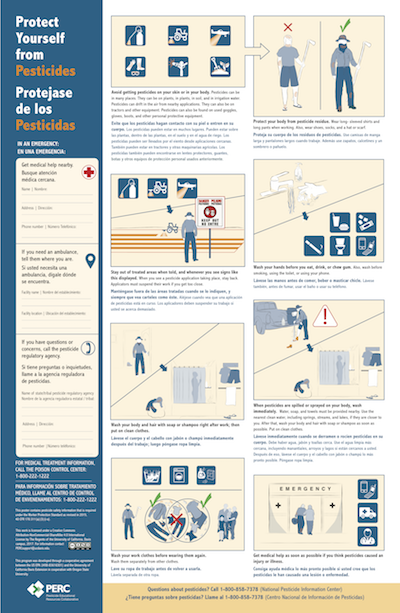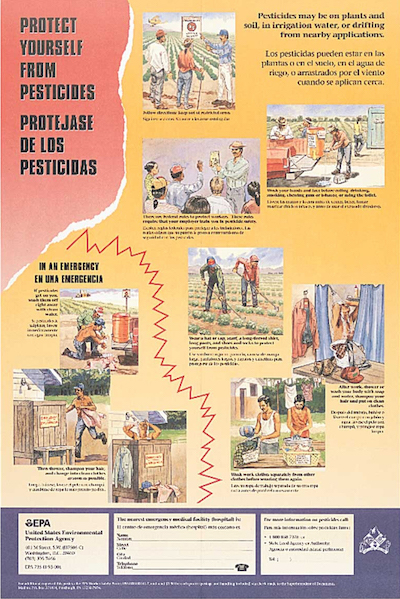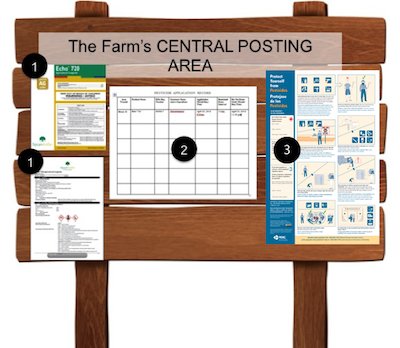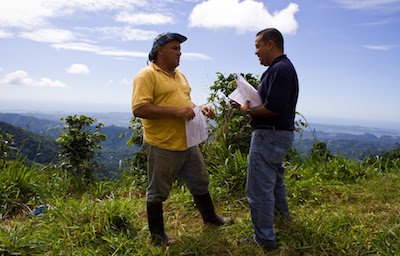Under the Worker Protection Standard (WPS) as revised in 2015, specific information must be available to agricultural workers and pesticide handlers at all times during their working hours.
What must be posted?
-
- Hazard information
-
- Safety Data Sheets (SDS) for each agricultural pesticide product applied in the last 30 days, or longer if there was a restricted-entry interval (REI).
-
- Hazard information
-
- Pesticide Application Information (Records)
-
- These records must be posted for each agricultural pesticide product applied in the last 30 days, or longer if there was a REI. Records must contain:
-
- Name of the pesticide product(s) applied,
-
- Active ingredient(s) of the pesticide product(s) applied,
-
- EPA registration number(s) of the pesticide product(s) applied,
-
- Restricted-entry Interval (REI),
-
- Crop or site treated,
-
- Location and description of the treated area(s), and
-
- Date(s) and time(s) application started and ended.
-
- These records must be posted for each agricultural pesticide product applied in the last 30 days, or longer if there was a REI. Records must contain:
-
- Pesticide Safety Information – A WPS poster or other equivalent materials. Updated posters are available here.
Where must it be posted?
Usually, a location is selected where employees congregate, such as where they check in or out of work, change clothes, eat, etc. Workers and handlers must be able to access safety information at any time during normal work hours.
In addition, "pesticide safety information" (the poster, usually) must be posted in permanent locations where employees wash up (i.e. out-buildings, portable restrooms with hand-washing supplies), and temporary locations where more than 10 employees wash up (i.e. tailgate hand-washing stations).
Can we "post" electronically?
Application records and hazard information (SDS) may be kept electronically. If you choose to keep information electronically, all workers must be able to use the computer or another device and must have continuous access to the documents during work hours.

When does this rule go into effect?
January 1, 2017 — Post the pesticide application information and hazard information (SDS), keep the old WPS poster in place.
January 1, 2018 — Post "Pesticide Safety Information" that is updated with newly expanded content, such as the poster below. Be sure to fill in the poster with your site-specific information before posting. Continue posting pesticide application information and hazard information (SDS).
Implementation dates may change.
Check back for updates from EPA.
View More
View Less

Previously, the 1992 WPS required posting:
- Pesticide application information — Application records had to include all of the same data points except “crop/site treated” and the start/end times of applications.
- Pesticide Safety Information — A WPS poster with fewer required pieces of information
One of the common posters that was used looked like this:
What is the purpose of posting these items?
The information is intended to:
- Help workers avoid pesticide-treated areas while restrictions are in place
- Protect workers and their families from unnecessary pesticide exposure
- Help workers understand the potential health effects of pesticide exposure
- Enable workers to share important details about pesticide exposure when they are seeking medical care
View More
View Less

What might "Central Posting" look like?
Image credit: Garnet Cooke, Oregon OSHA, modified by PERC
- Hazard Information — Includes Safety Data Sheet(s) for each pesticide
- Pesticide Application Information — Includes start and end of application, plus location and description
- Pesticide Safety Information — Includes WPS poster or equivalent information
Hazard Information (#1)
Safety data sheets for all pesticide applications are only required in English. As an employer, it is your responsibility that the SDS is posted or made available within 24 hours of an application. Workers may not enter treated areas under an REI until the SDS and application information (#2) is available.
- A binder in the office may be used to display or make available a collection of safety data sheets, as long as workers have access to the binder during working hours.
- A computer in the office may be used to display or make available a collection of safety data sheets as long as workers have the necessary skills and access during working hours.
Pesticide Application Information (#2)
As an employer, you must ensure the pesticide application and hazard information is displayed or made available for each pesticide product within 24 hours of the end of the application. You must also ensure pesticide application information is updated about changed application plans/details within 24 hours.
You must ensure pesticide application and hazard information is displayed until at least 30 days after the end of the last REI. If workers and handlers are no longer on the agricultural establishment during this time, this information does not need to be posted after they leave.
Pesticide Safety Information (#3)
You must include the following pesticide safety elements in a central location (1-10 below) by January 2, 2018. PERC developed a poster that includes the required information in English and in Spanish. They are available here.
If you choose to develop your own version, it does not need to be EPA-approved. However, it must include all elements discussed below.
- Avoid getting on the skin or into the body any pesticides that may be on or in plants, soil, irrigation water, tractors, and other equipment, on used personal protective equipment, or drifting from nearby applications.
- Wash before eating, drinking, using chewing gum or tobacco, or using the toilet.
- Wear work clothing that protects the body from pesticide residues (long- sleeved shirts, long pants, shoes and socks, and a hat or scarf).
- Wash or shower with soap and water, shampoo hair, and put on clean clothes after work.
- Wash work clothes separately from other clothes before wearing them again.
- If pesticides are spilled or sprayed on the body use decontamination supplies to wash immediately, or rinse off in the nearest clean water, including springs, streams, lakes or other sources if more readily available than decontamination supplies, and as soon as possible, wash or shower with soap and water, shampoo hair, and change into clean clothes.
- Follow directions about keeping out of treated areas and application exclusion zones.
- Instructions to employees to seek medical attention as soon as possible if they believe they have been poisoned, injured or made ill by pesticides.
- The name, address, and telephone number of a nearby operating medical care facility capable of providing emergency medical treatment. This information must be clearly identified as emergency medical contact information on the display.
- The name, address and telephone number of the State or Tribal pesticide regulatory agency.
View More
View Less
Do central posting materials need to be available in all languages spoken by workers and handlers on my establishment?
All pesticide safety information must be understandable for workers and handlers. This does not necessarily mean the materials must be translated. If images can adequately convey the required information, they may be sufficient for centrally-posted pesticide safety information.

Regulatory Guidance
Browse brief guides about protections for workers and handlers, the AEZ, posting, PPE, exemptions, training, respirators, and more, in English and Spanish.
